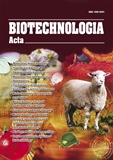ISSN 2410-7751 (Print)
ISSN 2410-776X (Online)

Biotechnologia Acta Т. 18, No. 2, 2025
P. 7-9, Bibliography 5 , Engl.
UDC 612.8:616.831-009.11:575.113
doi: https://doi.org/10.15407/biotech18.02.007
Full text: (PDF, in English)
HIPSC-DIFFERENTIATED DOPAMINERGIC NEURONS ARE A USEFUL TOOL FOR STUDYING THEIR NEUROPHYSIOLOGY AND MATURATION
.O. Pavlova 1,2, L. Vandries 2, V. Seutin 2
1 Palladin Institute of Biochemistry of the National Academy of Sciences of Ukraine, Kyiv;
2 Laboratory of Neurophysiology, GIGA-Neurosciences, University of Liege, Belgium
Dopaminergic (DA) neurons play a crucial role in motor control, motivation, and cognition, with their degeneration in Parkinson’s disease leading to severe motor deficits. While rodent models are widely used, species-specific differences necessitate human-relevant models.
Aim. This study investigates the functional maturation of DA neurons derived from human induced pluripotent stem cells (IPS).
Methods. DA differentiation was performed using a mCherry-based TH reporter iPS line. Immunocytochemistry confirmed neuronal identity, while patch-clamp recordings assessed electrophysiological properties, including firing rate, action potential duration, Ih current, and dopamine sensitivity.
Results. TH expression was detected from day 10, reaching 64% by day 30. Electrophysiological maturation followed a distinct timeline, with spontaneous activity emerging around day 20 and stable pacemaking developing by day 40, along with D2 receptor-mediated autoinhibition.
Conclusions. Our findings demonstrate that hIPSC-derived DA neurons attain an adult-like profile by day 40, making them a viable model for studying Parkinson’s disease mechanisms and testing potential therapies. Further research will focus on slow pacemaking mechanisms in these neurons.
Keywords: Dopaminergic neurones, human induced pluripotent stem cells, electrophysiology, pacemaking, Parkinson's disease.
© Palladin Institute of Biochemistry of the National Academy of Sciences of Ukraine, 2025
References
1. Michel, P. P., Hirsch, E. C., Hunot, S. (2016). Understanding Dopaminergic Cell Death
Pathways in Parkinson Disease. Neuron., 90(4), 675–691. https://doi.org/10.1016/j.
neuron.2016.03.038
2. Potashkin, J. A., Blume, S. R., Runkle, N. K. (2011). Limitations of Animal Models of
Parkinson’s Disease. Parkinsons Dis., 1–7. https://doi.org/10.4061/2011/658083
3. Stathakos, P., Jimenez-Moreno, N., Crompton, L., Nistor, P., Caldwell, M. A., Lane, J. D.
(2019). Imaging Autophagy in hiPSC-Derived Midbrain Dopaminergic Neuronal Cultures
for Parkinson’s Disease Research. In: Ktistakis, N., Florey, O. (Eds.) Autophagy. Methods
in Molecular Biology, 1880. Humana Press, New York, NY. 257–280. https://doi.
org/10.1007/978-1-4939-8873-0_17
4. Borgs, L., Peyre, E., Alix, P., Hanon, K., Grobarczyk, B., Godin, J. D., Purnelle, A., Krusy, N.,
…, Nguyen, L. (2016). Dopaminergic neurons differentiating from LRRK2 G2019S induced
pluripotent stem cells show early neuritic branching defects. Sci. Rep., 6(1), 33377. https://
doi.org/10.1038/srep33377
5. Seutin, V. (2021). Electrophysiological Quality Control of Human Dopaminergic Neurons: Are
We Doing Enough? Front Cell Neurosci., 15. https://doi.org/10.3389/fncel.2021.715273

